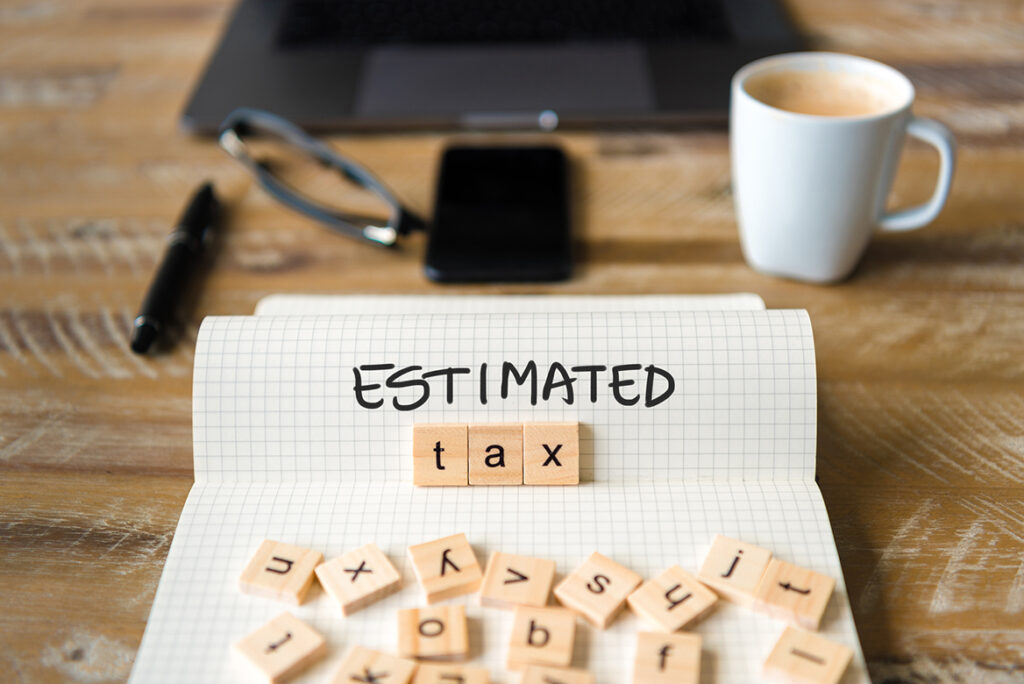Depending on what you do for a living and what your spouse may be earning, you may have income that is not subject to withholding. It’s possible that you may need to pay estimated taxes.
We’re halfway through 2022. What’s worse than finding out you are shocked by the tax owed on your 2022 personal income tax return? How about learning that you may have to ALSO pay next years income taxes starting the same time?
You may need to pay estimated taxes to the IRS and one or more states during the year if you have income that is not subject to withholding. This can depend on what you do for a living, what your spouse may be earning when you file jointly and the types of income you receive.
Download Printable Article PDF >>>

11 Points to Consider Regarding Estimated Taxes
Here are eleven points we at Abo and Company would at lease like you to consider regarding your estimated taxes if you need to pay them and how to pay them.
- If you have income from sources such as self-employment, interest, dividends, alimony, rent, gains from the sales of assets, prizes or awards, then you may have to pay estimated tax. You also may have to pay estimated tax if the amount of income tax being withheld from your salary, pension or other income is not enough. Estimated tax is used to pay income tax and self employment tax, as well as other taxes and amounts reported on your tax return.
- As a general rule, you must pay federal estimated taxes if both of these statements apply: 1) You expect to owe at least $1,000 in tax after subtracting your tax withholding (if you have any) and tax credits, and 2) You expect your withholding and credits to be less than the smaller of 90 percent of your 2022 taxes or 100 percent of the tax on your 2021 return. If your 2021 Adjusted Gross Income was more than $150,000 ($75,000 if Married Filing Separately) substitute 110% for the 100% requirement. Your 2021 tax return must cover all 12 months.
- For Sole Proprietors, Partners and S Corporation shareholders, you generally should make estimated tax payments if you expect to owe $1,000 or more in tax when you file your return.
- If you also receive salaries and wages, you may be able to avoid having to make estimated tax payments on your other income by asking your employer to take more tax out of your earnings. To do this, file a new Form W-4, Employee’s Withholding Allowance Certificate, with your employer. Generally, if you receive a pension, annuity or certain other deferred compensation payments you can use Form W-4P, Withholding Certificate for Pension or Annuity Payments, to start or change your
withholding from these payments. You also can choose to have federal income tax withheld from certain government payments using Form W-4V, Voluntary Withholding Request (i.e. unemployment compensation, social security benefits, etc. - To figure your estimated tax, include your expected gross income, taxable income, taxes, deductions and credits for the year. You can use the worksheet in Form 1040-ES, Estimated Tax for Individuals, for this. You want to be as accurate as possible to avoid penalties. Also, consider
changes in your situation and recent tax law changes. Many a client will have Abo and Company prepare tax projections for them and even have them updated as the year progresses. Your call. - The year is divided into four payment periods, or due dates, for estimated tax purposes. Those
dates for this coming year are April 18, 2022; June 15, 2022; Sept. 15, 2022 and Jan. 17, 2023.
As you can see, estimated tax payments are made in four quarterly installments and can be based on a regular tax method or an annualized income installment method. - You can make more than four estimated tax payments. To do so, make a copy of one of your unused estimated tax payment vouchers, fill it in, and mail it with your payment. If you make more than four payments, to avoid a penalty, make sure the total of the amounts you pay during a payment period is at least as much as the amount required to be paid by the due date for that period.
- The disadvantage to utilizing the annualized method as opposed to the regular method is that the calculation of your estimated tax payments may be more complex and time consuming. Additionally, your estimated tax payments must be recalculated at the end of every quarter. If you make an estimated tax payment using the annualized income method for a quarter, you may change to the regular method for a subsequent quarter but you must recapture the difference between the annualized income installments and the regular installments by adding the amount of the differential for all previous periods to the regular installment for the next payment period. For example, if you estimated a tax of $1,000 under the regular method, $250 would be due each quarter. If you used the annualized method for the first quarter and paid $100, and then shifted to the regular method for the second quarter, the second quarter installment due would be $400 ($250 for the second quarter plus $150 unpaid for the first quarter).
- An underpayment penalty is imposed on each underpayment for the number of days it remains unpaid. A penalty may be applied if you did not pay enough estimated tax for the year or you did not make the payments on time or in the required amount. A penalty may even apply if you have an overpayment on your tax return. Interest/penalty rates as of this writing is at 3% per annum. Not necessarily the worst.
- If you extended your 2021 return considering the original due date of April 18, 2022 has passed, if you only have so much in funds available to pay the balance of your 2021 tax liabilities as well as 2022 estimated tax payments, our vote is generally to pay the 2021 amounts due IRS and/or the states.
- Estimated taxes should be calculated for all states for which you will be filing individual resident or nonresident tax returns. For purposes of calculating estimates for most states, either the regular installment or annualized income installment method may be used.
Many of Abo and Company clients typically call asking why we include 2022 estimated tax vouchers with their 2021 tax returns. When there is a material balance due on their federal or state 2021 return, we may often produce such safe-harbor estimates if we are unsure if the client will be having similar balances due this time next year. After discussing with us, clients often consider increasing their withholdings to so avoid the need for paying such estimates. Again, your personal call.
Martin H. Abo, CPA/ABV/CVA/CFF is the principle of Abo and Company, LLC and affiliate, Abo Cipolla Financial Forensics, LLC, Certified Public Accountants – Litigation and Public Accountants. With offices located in Mount Laurel, New Jersey and Morrisville, Pennsylvania, tips like the above can also be accessed
For more information, contact:
 Martin H. Abo, CPA/ABV/CVA/CFF
Martin H. Abo, CPA/ABV/CVA/CFF
307 Fellowship Road, Suite 202
Mt. Laurel, NJ 08054
(856) 222-4723 ext. 104
marty@aboandcompany.com
www.aboandcompany.com



